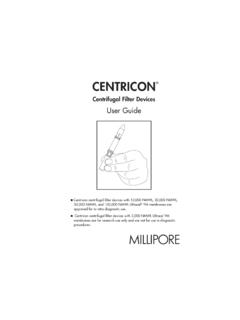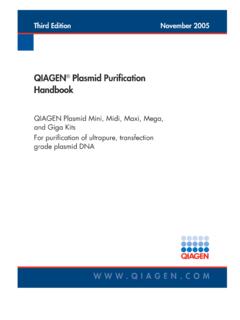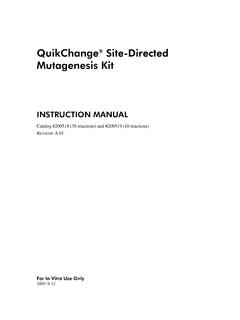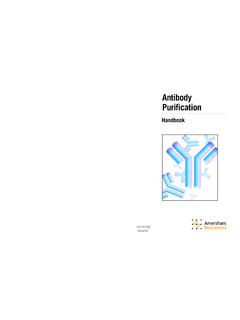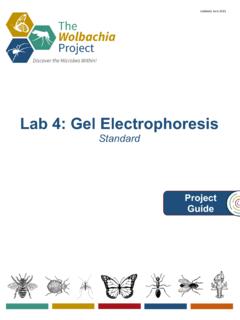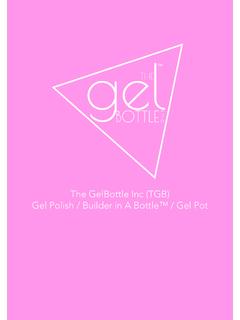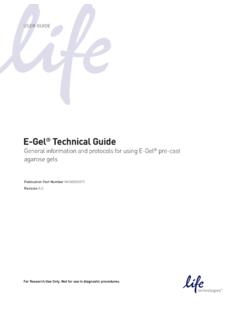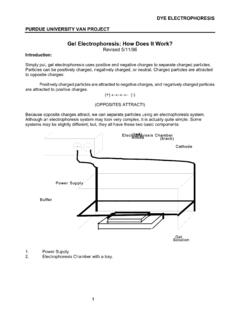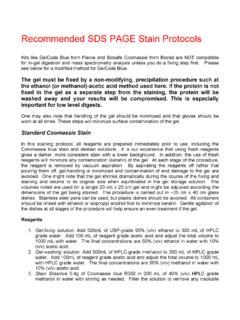Transcription of Gel Filtration - Harvard University
1 18-1022-18 Edition AIGel Filtration Handbook Principles and : RAK Design ABPrinciples and MethodsGel FiltrationHandbooksfrom Amersham Biosciences KTA, FPLC, PlusOne, HiLoad , HiTrap, HiPrep, Hybond, ECL, ECL Plus, BioProcess, MabSelect, Sephacryl,Sephadex, Superose, Sepharose, Superdex and Drop Design are trademarks of Amersham Biosciences and Amersham Biosciences are trademarks of Amersham is a trademark of ICI is a trademark of Lida Manufacturing is a registered trademark of Union Carbide Chemicals and Plastics is a registered trademark of ICI Americas, and Multipipette are trademarks of Eppendorf-Netheler-Hinz is a trademark of Biacore goods and services are sold subject to the terms and conditions of sale of the company within the AmershamBiosciences group that supplies them.
2 A copy of these terms and conditions is available on request. Amersham Biosciences AB 2002 All rights Biosciences AB, Bj rkgatan 30, SE-751 84 Uppsala, SwedenAmersham Biosciences UK Limited, Amersham Place, Little Chalfont, Buckinghamshire HP7 9NA, EnglandBiosciences Corp., 800 Centennial Avenue, PO Box 1327, Piscataway NJ 08855, USAA mersham Biosciences Europe GmbH, Munzinger Strasse 9, D-79111 Freiburg, GermanyAmersham Biosciences , Sanken Bldg. 3-25-1, Hyakunincho Amersham Shinjuku-ku, Tokyo 169-0073, and Applications18-1115-69 Ficoll-Paque PlusFor in vitro isolation of lymphocytes18-1152-69 GST Gene Fusion SystemHandbook18-1157-582-D Electrophoresisusing immobilized pH gradientsPrinciples and Methods80-6429-60 Antibody PurificationHandbook18-1037-46 The Recombinant Protein HandbookProtein Amplification and Simple Purification18-1142-75 Protein PurificationHandbook18-1132-29 Ion Exchange ChromatographyPrinciples and Methods18-1114-21 Affinity ChromatographyPrinciples and Methods18-1022-29 Hydrophobic Interaction ChromatographyPrinciples and Methods18-1020-90 Gel FiltrationPrinciples and Methods18-1022-18 Reversed Phase ChromatographyPrinciples and Methods18-1134-16 Expanded Bed
3 AdsorptionPrinciples and Methods18-1124-26 Chromatofocusingwith Polybuffer and PBE18-1009-07 Microcarrier cell culturePrinciples and Methods18-1140-621 Gel filtrationPrinciples and 5 Symbols .. 6 Common 7 Chapter 1 Gel Filtration in practice .. 9 Separation by gel 9 Resolution in gel Filtration .. 13 Media 16 Sample preparation .. 20 Buffer composition and preparation .. 21 Denaturing (chaotropic) agents and 22 Column and media preparation .. 23 Sample 23 Elution and flow rates .. 24 Method development for high resolution 26 Care of gel Filtration media .. 27 Equipment 27 Scaling 27 BioProcess Media for large-scale production .. 29 Chapter 2 Gel Filtration media.
4 35 Components of gel Filtration media .. 35 Superdex: first choice for high resolution, short run times and high recovery .. 36 Separation 38 Separation examples .. 39 Performing a 42 Cleaning .. 43 Media 44 Chemical 44 Storage .. 44 Sephacryl: fast, high recovery separations at laboratory and industrial scale .. 45 Separation 48 Separation examples .. 48 Performing a 49 Cleaning .. 50 Media 51 Chemical 51 Storage .. 51 Superose: broad fractionation range, but not suitable for industrial scale separations .. 523 Separation 53 Separation examples .. 54 Performing a 54 Cleaning .. 55 Media 56 Chemical 56 Storage .. 56 Sephadex: rapid group separation of high and low molecular weight substances,such as desalting, buffer exchange and sample clean up.
5 57 Separation 59 Separation examples .. 61 Performing a 61 Scale up and processing large sample 66 Media 68 Column 68 Cleaning .. 68 Chemical 68 Storage .. 69 Chapter 3 Gel Filtration in theory .. 71 Defining the process .. 71 Selectivity curves and media selection .. 75 Chapter 4 Molecular weight determination and molecular weight distribution analysis .. 79 Chapter 5 Sephadex LH-20 .. 81 Separation 82 Separation examples .. 82 Packing a 83 Performing a 84 Cleaning .. 84 Medium 84 Chemical 85 Storage .. 85 Transferring Sephadex LH-20 between organic 85 Chapter 6 Gel Filtration in a Purification Strategy (CIPP) .. 87 Applying 87 Selection and combination of purification 88 Gel Filtration as a polishing 914 Appendix 1 Column packing and preparation.
6 93 Columns for packing gel Filtration 93 Checking column 95 Column packing for high resolution fractionation using Superdex prep grade andSephacryl High Resolution .. 95 Column packing for group separations using Sephadex .. 98 Appendix 2 Sephadex and Darcy's law .. 102 Appendix 3 Sample preparation .. 103 Sample 103 Sample 104 Specific sample preparation steps .. 105 Removal of lipoproteins ..108 Removal of phenol red .. 108 Removal of low molecular weight contaminants .. 108 Appendix 4 Selection of purification equipment .. 109 Appendix 5 Converting from linear flow (cm/hour) to volumetricflow rates (ml/min) and vice versa .. 110 Appendix 6 Conversion data: proteins, column pressures.
7 111 Appendix 7 Table of amino acids .. 112 Appendix 8 Analytical assays during purification .. 114 Appendix 9 Storage of biological samples .. 116 Additional reading and reference material .. 117 Ordering information .. 1185 IntroductionBiomolecules are purified using chromatography techniques that separate them according todifferences in their specific properties, as shown in Figure Filtration (GF), also called size exclusionChargeIon exchange chromatography (IEX)HydrophobicityHydrophobic interaction chromatography (HIC)Reversed phase chromatography (RPC)Biorecognition (ligand specificity)Affinity chromatography (AC)Gel filtrationHydrophobic interactionIon exchangeAffinityReversed phaseFig.
8 1. Separation principles in chromatography more than forty years since the introduction of Sephadex , gel Filtration has played akey role in the purification of enzymes, polysaccharides, nucleic acids, proteins and otherbiological macromolecules. Gel Filtration is the simplest and mildest of all the chromato-graphy techniques and separates molecules on the basis of differences in size. The techniquecan be applied in two distinct ways:1. Group separations: the components of a sample are separated into two major groupsaccording to size range. A group separation can be used to remove high or low molecularweight contaminants (such as phenol red from culture fluids) or to desalt and High resolution fractionation of biomolecules: the components of a sample are separatedaccording to differences in their molecular size.
9 High resolution fractionation can be usedto isolate one or more components, to separate monomers from aggregates, to determinemolecular weight or to perform a molecular weight distribution Filtration can also be used to facilitate the refolding of denatured proteins by carefulcontrol of changing buffer Filtration is a robust technique that is well suited to handling biomolecules that aresensitive to changes in pH, concentration of metal ions or co-factors and harsh environmentalconditions. Separations can be performed in the presence of essential ions or cofactors,detergents, urea, guanidine hydrochloride, at high or low ionic strength, at 37 C or in thecold room according to the requirements of the handbook describes the use of gel Filtration for the purification and separation ofbiomolecules, with a focus on practical information for obtaining the best results.
10 The mediaavailable, selection criteria and examples with detailed instructions for the most commonapplications are included, as well as the theoretical principles behind the technique. The firststep towards a successful separation is to select the correct medium and this handbookfocuses on the most up-to-date gel Filtration media and prepacked biocompatibility, stability and utility of gel Filtration media from Amersham Bioscienceshave made these products the standard choice in practically every laboratory using thetechnique. A wide variety of prepacked columns and ready to use media is illustration on the inside cover shows the range of handbooks from AmershamBiosciences that have been produced to ensure that chromatography and other separationtechniques are used easily and effectively at any scale, in any laboratory and for symbol indicates general advice which can improve procedures or providerecommendations for action under specific symbol denotes advice which should be regarded as mandatory and gives a warningwhen special care should be symbol highlights troubleshooting advice to help analyse and resolve difficulties thatmay , buffers and abbreviationsIn chromatographyGF.

